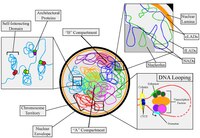
Photo from wikipedia
Erosion and deposition redistribute mass as a continental rift evolves, which modifies crustal loads and influences subsequent deformation. Surface processes therefore impact both the architecture and the evolution of passive… Click to show full abstract
Erosion and deposition redistribute mass as a continental rift evolves, which modifies crustal loads and influences subsequent deformation. Surface processes therefore impact both the architecture and the evolution of passive margins. Here we use coupled numerical models to explore the interactions between the surface, crust, and lithosphere. This interaction is primarily sensitive to the efficiency of the surface processes in transporting mass from source to sink. If transport is efficient, there are two possible outcomes: (1) Faulting within the zone of extension is longer lived and has larger offsets. This implies a reduction of the number of faults and the width of the proximal domain. (2) Efficient transport of sediment leads to significant deposition and hence thermal blanketing. This will induce a switch from brittle to ductile deformation of the upper crust in the distal domains. The feedbacks between these two outcomes depend on the extension history, the underlying lithospheric rheology, and the influence of submarine deposition on sediment transport. High erosion/sedimentation during early faulting leads to abrupt crustal necking, while intermediate syntectonic sedimentation rates over distal deep submarine hotter crust leads to unstructured wide distal domains. In models where rheological conditions favor the formation of asymmetric conjugate margins, only subaerial transport of sediments into the distal domains can increase conjugate symmetry by plastic localization. These models suggest that passive margin architecture can be strongly shaped by the solid Earth structure, sea level, and climatic conditions during breakup.
Journal Title: Tectonics
Year Published: 2019
Link to full text (if available)
Share on Social Media: Sign Up to like & get
recommendations!